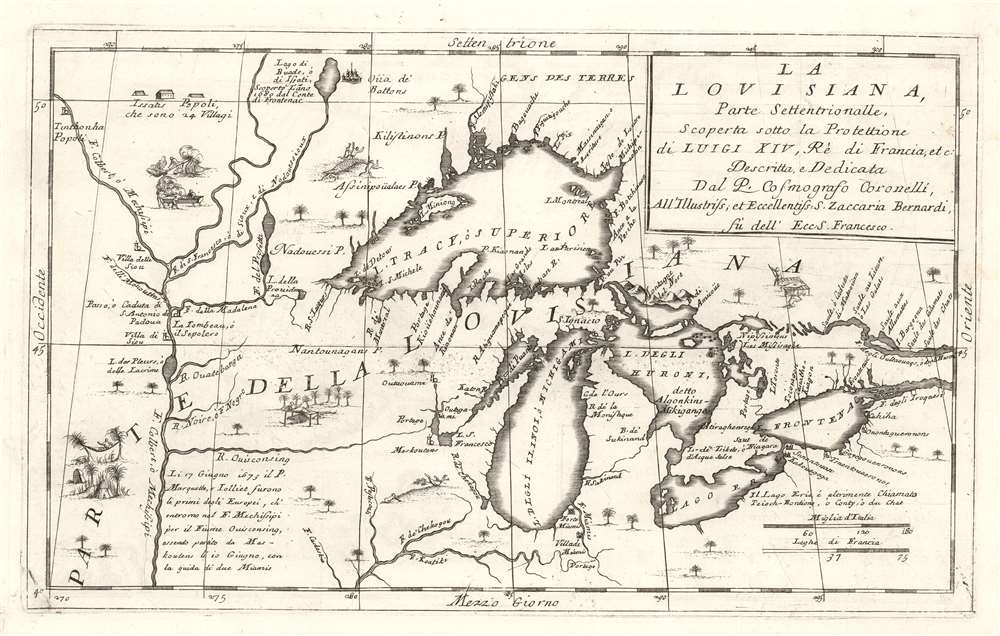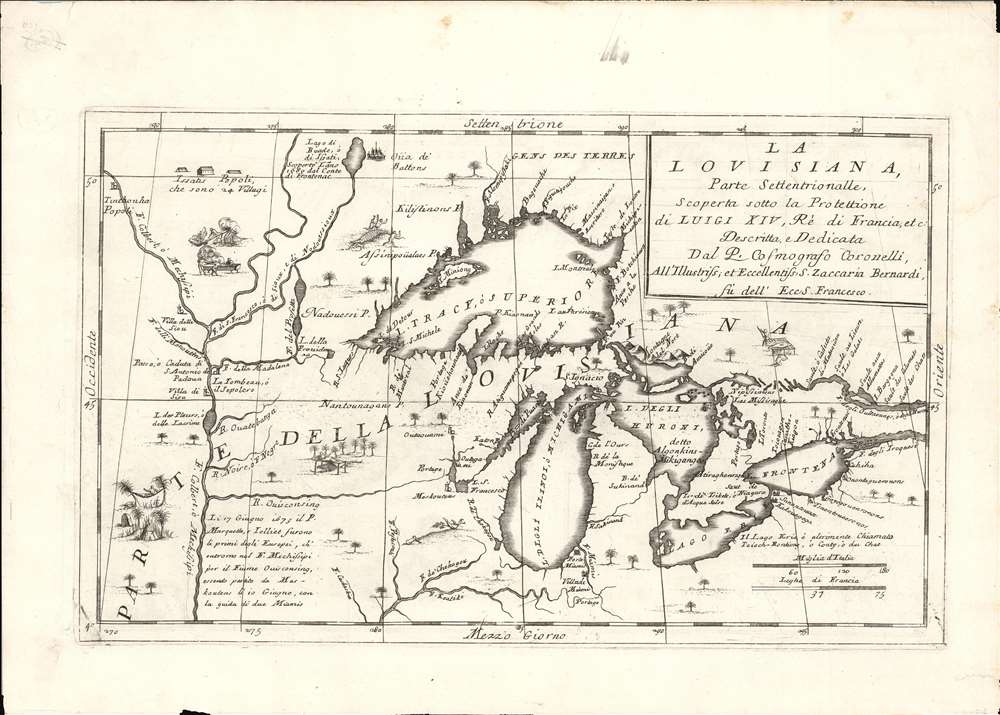This item has been sold, but you can get on the Waitlist to be notified if another example becomes available, or purchase a digital scan.
1694 Coronelli Map of Great Lakes (Best 17th C. Map of Great Lakes)
LaLouisiana-coronelli-1695-2
Title
1695 (undated) 10.5 x 16.5 in (26.67 x 41.91 cm) 1 : 5069000
Description
Sources and Content
Coronelli derived his cartographic information from the reports of Jesuit Missionaries, most of which were collected by Jean Baptiste-Louis Franquelin, who effectively acted as a clearing house of cartographic information flowing out of French America. The map's detail is informed by the explorations of La Salle, Hennepin, Marquette, Jolliet, Dablon, and Allouez, among others. The traces of their travels can be found throughout. Lake Ontario is named Frontenac, after the Governor of New France. On the north shore of Lake Erie, the three peninsulas are clearly visible in their third time in print (two previous though more general Coronelli publications). Fort Miami, founded by La Salle, appears at the southern tip of Lake Michigan. Various portages used by explorers and fur traders are noted throughout. Coronelli identifies the R. De Chekagou roughly where Chicago is today, as well as a portage to the F. de Chekogou just to the southwest This is also the most accurate early mapping of Lake Superior, in which both Keweenaw Peninsula (P. Kioanan) and Isle Royale (I. Miniong) are located.Charming Vignettes
Coronelli has decorated the map throughout with numerous wonderful vignettes depicting the day-to-day lives of American Indians. One in particular, a crocodile eating a man, is interesting and incongruous.Publication History and Census
This map was prepared for inclusion in the second edition of Coronelli's important 1695 Atlante Veneto. It is derived from the more general 1688 Nolin/Coronelli map, Partie Occidentale du Canada ou de la Nouvelle France. No map of comparable quality of the region would be produced until the Charlevoix/Bellin map of 1744. This is a keystone map for any Great Lakes collection.Cartographer
Vincenzo Maria Coronelli (August 16, 1650 - December 9, 1718) was an important 17th-century cartographer and globe maker based in Venice. Coronelli was born the fifth child of a Venetian tailor. Unlikely to inherit his father's business, he instead apprenticed in Ravenna to a woodcut artist. Around 1663, Coronelli joined the Franciscan Order and, in 1671, entered the Venetian convent of Saint Maria Gloriosa dei Frari. Coronelli excelled in the fields of cosmography, mathematics, and geography. Although his works include the phenomenal Atlante Veneto and Corso Geografico, Coronelli is best known for his globes. In 1678, Coronelli was commissioned to make his first major globes by Ranuccio II Farnese, Duke of Parma. Each superbly engraved globe was five feet in diameter. Louis IV of France, having heard of the magnificent Parma globes, invited Coronelli to Paris, where from 1681-83 he constructed an even more impressive pair of globes measuring over 12 feet in diameter and weighing 2 tons each. The globes earned him the patronage of Louis XIV and privileged access to French cartographic information from Jesuit sources in the New World, particularly Louisiana. Coronelli returned to Venice and continued to publish globes, maps, and atlases, which were admired all over Europe for their beauty, accuracy, and detail. He had a particular fascination for the Great Lakes region, and his early maps of this area were unsurpassed in accuracy for nearly 100 years after their initial publication. He is also well known for his groundbreaking publication of the first accurate map depicting the sources of the Blue Nile. At the height of his career, Coronelli founded the world's first geographical society, the Accademia Cosmografica degli Argonauti, and was awarded the official title Cosmographer of the Republic of Venice. In 1699, in recognition of his extraordinary accomplishment and scholarship, Coronelli was also appointed Father General of the Franciscan Order. The great cartographer and globe maker died in Venice at the age of 68. His extraordinary globes can be seen today at the Bibliothèque Nationale François Mitterrand in Paris, Biblioteca Marciana in Venice, the National Library of Austria, the Globe Museum in Vienna, the Library of Stift Melk, the Special Collections Library of Texas Tech University, as well as lesser works in Trier, Prague, London, and Washington D.C. Coronelli's work is notable for its distinctive style, which is characterized by the high-quality white paper, dark intense impressions, detailed renderings of topographical features in profile, and numerous cartographic innovations. More by this mapmaker...




